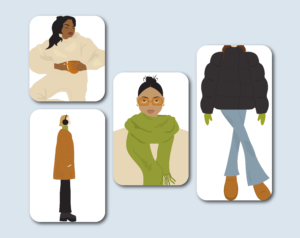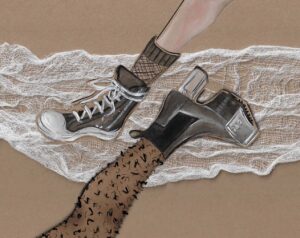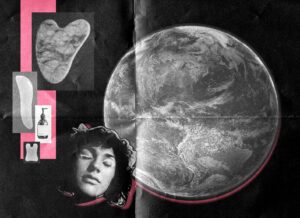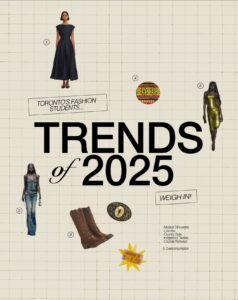Featured Graphic by: Alicia Churilla
Who doesn’t love a good ol’ American fashion trend? Jackie Kennedy, the Kardashians, Hilary Clinton – do those names ring a bell? Everyone has an opinion about American politics, trends, and fashion, from pedal pushers to bell bottoms to Hilary’s much debated pant suits. There seems to be no end to how fashion both sexualizes, politicizes and idealizes the bodies of American women. After all, did Trump really have nothing better to comment on than Hilary’s fashion choices? But at Style Circle we like to keep our political opinions saved for light dinner table discussions, and are especially up for a hearty debate when great uncle Joe is there, bless his soul…
We’re going to be real with you for a moment because this next topic is not debatable and at Style Circle we know how much the public loves a juicy American fashion trend to gossip about and really sink their teeth into. Consider this next statement a spilling of the tea so to say… nothing screams America like a pair of denim pants, whether you swear by Levi’s, plunge toilets for a living, or pick up designer coffee in your Carhartts. Maybe you nibble on kale salad during your lunch break in Khloe Kardashian’s latest denim line – regardless, we all know the real skeleton in the closet is nothing other than your most worn pair of blue denim babies.
Before the Kardashians were shooting their Xmas cards in Canadian tuxedos and you were stocking up on Urban Outfitter BDG skinnies, there was actually a time when denim was not so hot. Today denim is a staple in anybody’s wardrobes but its origins can be traced back to 1837 when the patent for the pants were made. Created by Levi Strauss and Jacob Davis, they were highly functional cotton pants with incredible durability. They were almost exclusively worn by men in blue collar jobs and at this point denim didn’t exactly have the same sex appeal as it has today. People who wore denim included labour workers such as: farmers, cowboys, ranchers, miners, lumberjacks, pioneers, construction workers, mechanics, and railroad engineers.

Jump to 1940’s when Claire McCardell, an American fashion designer from a wealthy family and Parsons grad, introduced “The American Look”. McCardell did the unthinkable and brought denim into high style. She was also responsible for the “the popover” (a denim house dress with an apron/cooking mitt at the waistband), the ticking/engineer stripe, the spaghetti belt, the baby dress, play wear, and our personal favourite, the “diaper swimsuit”.
Let us remember that during the 1940’s utility clothing was at its peak. Utility clothing was basically like a uniform for civilians and made it hard to express individuality. Women who were in the workforce wore a “snood” to cover their hair. There was a curfew for citizens in the UK and they used black-out cloth to deter bombers. The Nazis occupied Paris, which resulted in haute couture being cut off from America. This catapulted American designers such as McCardell to implement their own designs into the fashion sphere.
In the 1960’s, fashion became more liberating, even seeing blue jeans being worn by more women as a form of style. Brands like Wrangler, Dickie’s and Levi’s were some of the wholesome American denim brands growing in popularity at this time, most of which we now scan the racks for at our beloved thrift shops.
Fast forward to the 70’s when men and women dressed to their own liking. Rules about glove lengths, pant crops, and skirt hems were disappearing and trends were harder to identify because fashion became a melting pot of many different inspirations and looks, leading to a more “creative” way of dressing so to speak. The iconic “bell bottom” jeans were invented at the height of hippie culture, as well as jeans in a multitude of colours.
The women’s movement had its biggest impact in the early years of the 70’s. The term “Ms.” as opposed to “Miss” or “Mrs” was introduced, which meant women were no longer defined or addressed according to their marital status. This also had a huge role in how women began to dress as they defied the female stereotypes in a wardrobe that they were previously so accustomed to.
At this time, there also became a major interest in health food and citizens were increasingly body conscious. A new focus on the “bum” was brought to attention courtesy of Calvin Klein jeans. American brands like Calvin Klein, Ralph Lauren and Perry Ellis ruled and rocked the 70s and the first minimalist designer (also American) Halston influenced the lives of women and has left a mark to this day. Halston’s designs “rescued” a lot of American women at a time when gypsy and ethnic styles were a huge trend across Europe. Not to mention the 70s paved way to a new group of designers…the Japanese (most notably, Yohji Yamamoto, Rei Kawakubo, and Issey Miyake).
Let’s not forget the blessed invention of high waisted jeans! The saviour of our food babies! Jeans that basically buttoned up at the ribcage came about in the 80’s, elongating the legs of men and women everywhere. It was also in the 80’s that we saw acid-washed jeans and pegged (rolled-up) jeans come into popularity.
Then in the 90’s, not only were the ever-comfortable style of “Mom jeans” hitting the mainstream, but so was the idea that jeans could actually be sexy! Calvin Klein brought Kate Moss and Marky Mark (Mark Wahlberg) onto the scene with their topless denim ads that oozed sex appeal and inspired youth across America. Jeans were sexy. Denim jackets were sexy. Denim skirts were sexy. If Kate Moss threw on a piece of raw meat and wore it as a bra in a Calvin Klein ad that would probably be sexy too!
Rock n’ roll, punk, all these musical phenomenons and music industry stars were producing music full of angst and songs of rebellion. Denim represented a new wave of teen punks that were doing everything their parents told them NOT to do. When teens went out at night they wanted to emulate the same looks and attitudes as the the rockstars, models, and celebrities they admired on screen. Mass marketing and consumerism culture had massive influence on the youth, but in an inevitably cyclical way, it was also the youth that dominated and dictated what was hot and what was not.

For those who thought denim would just fade away like all the other fads, they could not have been more wrong. Denim today is ever as strong. In this century alone, we’ve witnessed the rise and (thankfully) fall of the skinny jeans and jeggings, as well as the return of old styles that have mentioned in today’s denim history lesson. Today, denim comes in every shade imaginable and if you take a pair of scissors or let your dog rip into them, you’ll be incredibly stylish.
Denim is constantly changing – it is so versatile and opportunistic. Yes, we’ve seen trends come and go out of style, politics have changed, attitudes have changed, and designers like McCardell’s names’ may not be remembered anymore, but the chosen cloth of America has stayed true, because the fact is, the country still lives, loves, and laughs in their favourite pair of blue jeans.






































